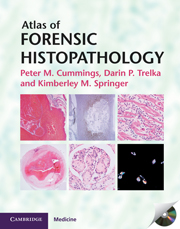4 - Aspiration and drowning
Published online by Cambridge University Press: 05 August 2013
Summary
INTRODUCTION
Food may enter the airway as it is traveling from the mouth to the stomach or it may be regurgitated. Frequently deaths involve elderly individuals or persons with neurological disorders; however, death from such causes can occur in any age group. A good example is the “café coronary” where middle-aged individuals die suddenly during a meal with no signs of distress. At autopsy, these people often have large pieces of food lodged in the pharynx or larynx. The mechanism is thought to be related to the vaso-vagal reflex. The discovery of food in the airway is by no means diagnostic of aspiration. Gastric contents are commonly found in the larynx and the trachea after death. The presence of food in the small airways is also commonly seen during review of microscopic slides of the airways. The best way to determine if an aspiration event occurred is by the history. If survival is prolonged, a vital reaction may occur in the airway resulting in inflammation and necrosis. Often this is a late change and not seen if death was less than a few hours after the event. When gastric contents are seen microscopically and no other lesions are identified at autopsy, it is tempting to attribute death to aspiration, especially in cases of sudden infant death. This approach can have devastating consequences for families who may believe that they missed an episode of vomiting that may have caused the infant’s death.
- Type
- Chapter
- Information
- Atlas of Forensic Histopathology , pp. 48 - 52Publisher: Cambridge University PressPrint publication year: 2000



